Evaluation of Rio Tinto's Adherence to the Conceptual Framework
VerifiedAdded on 2023/06/15
|11
|2185
|211
Report
AI Summary
This report critically analyzes Rio Tinto's adherence to the conceptual framework for financial reporting, based on its annual report. It examines the company's compliance with the five basic elements of the framework: assets, liabilities, equity, income, and expenses. The report assesses whether Rio Tinto meets the recognition criteria and fundamental qualitative characteristics (relevance and faithful representation), as well as enhancing qualitative characteristics (comparability, verifiability, timeliness, and understandability). The analysis concludes that Rio Tinto effectively incorporates all elements of the conceptual framework in its financial reporting, ensuring transparency and facilitating informed decision-making for stakeholders. Desklib provides access to similar reports and solved assignments for students.
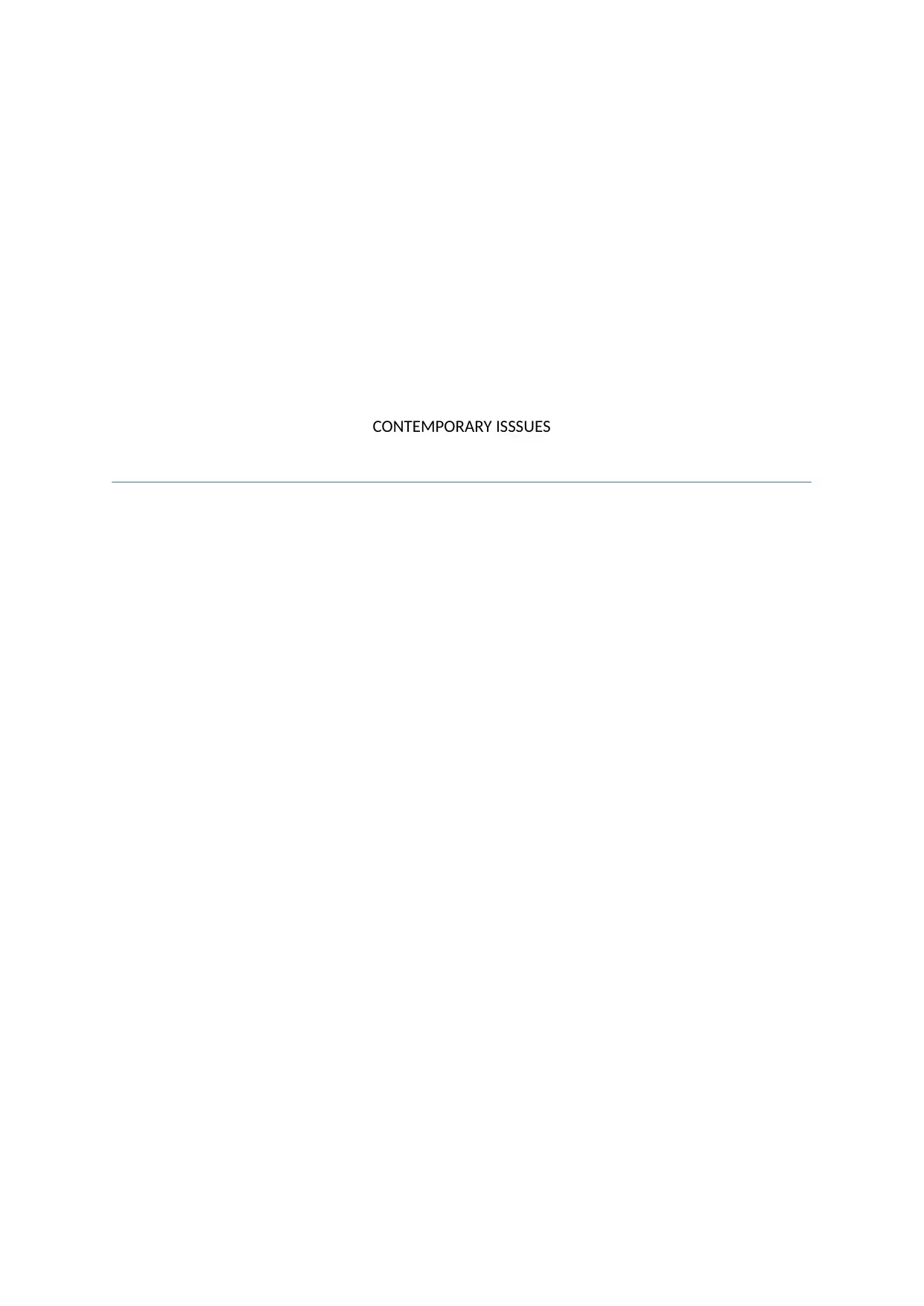
CONTEMPORARY ISSSUES
Paraphrase This Document
Need a fresh take? Get an instant paraphrase of this document with our AI Paraphraser
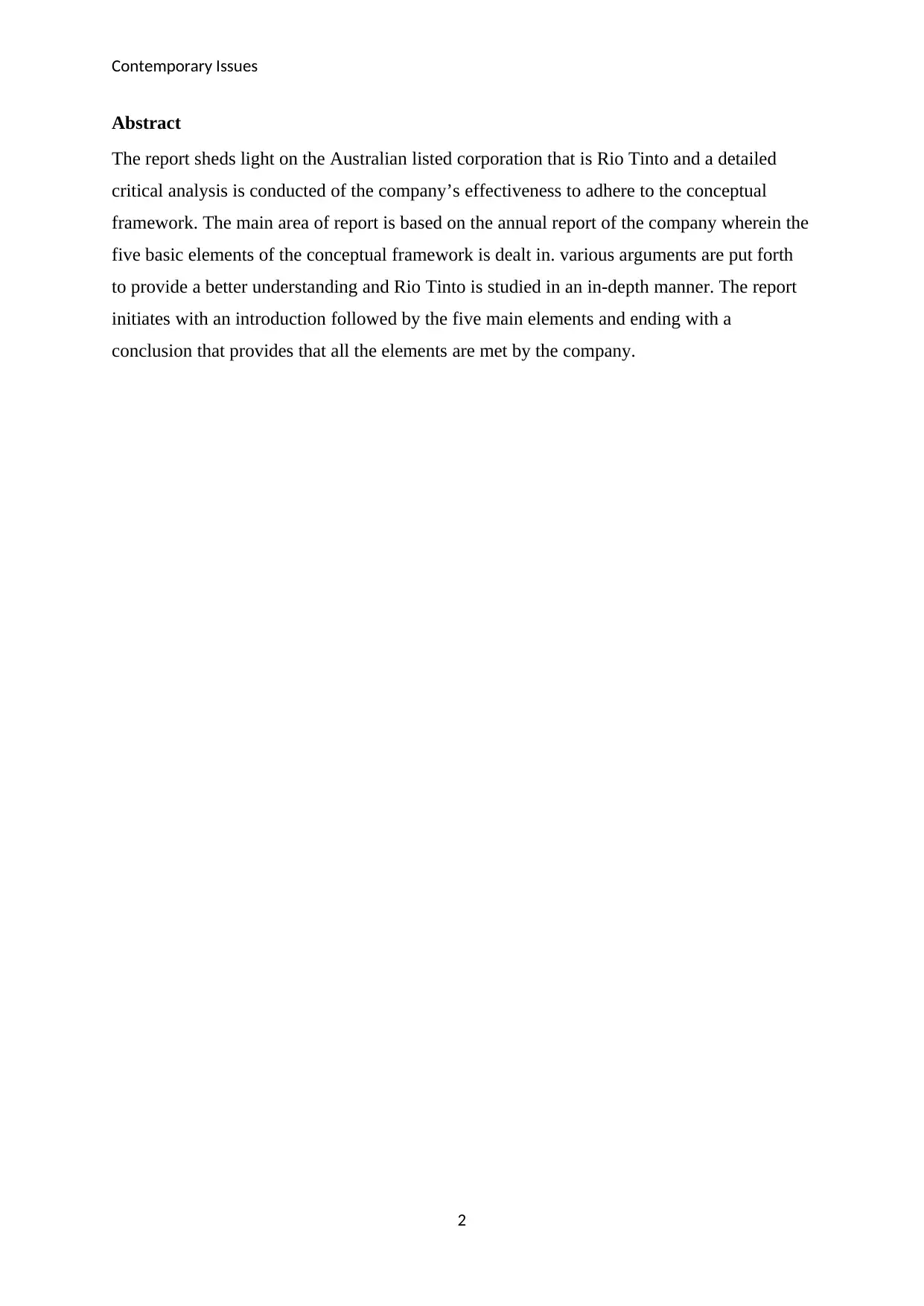
Contemporary Issues
Abstract
The report sheds light on the Australian listed corporation that is Rio Tinto and a detailed
critical analysis is conducted of the company’s effectiveness to adhere to the conceptual
framework. The main area of report is based on the annual report of the company wherein the
five basic elements of the conceptual framework is dealt in. various arguments are put forth
to provide a better understanding and Rio Tinto is studied in an in-depth manner. The report
initiates with an introduction followed by the five main elements and ending with a
conclusion that provides that all the elements are met by the company.
2
Abstract
The report sheds light on the Australian listed corporation that is Rio Tinto and a detailed
critical analysis is conducted of the company’s effectiveness to adhere to the conceptual
framework. The main area of report is based on the annual report of the company wherein the
five basic elements of the conceptual framework is dealt in. various arguments are put forth
to provide a better understanding and Rio Tinto is studied in an in-depth manner. The report
initiates with an introduction followed by the five main elements and ending with a
conclusion that provides that all the elements are met by the company.
2
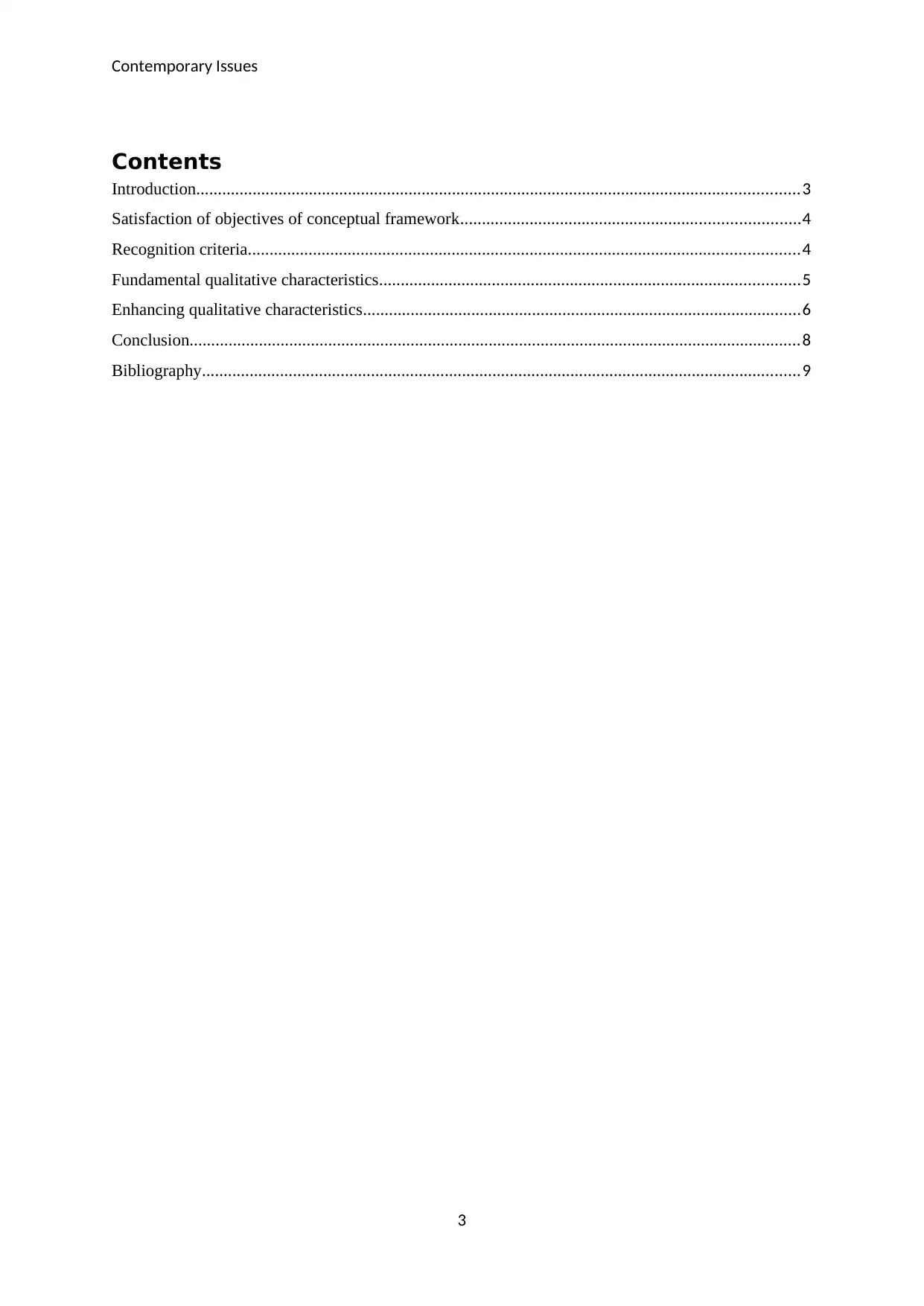
Contemporary Issues
Contents
Introduction...........................................................................................................................................3
Satisfaction of objectives of conceptual framework..............................................................................4
Recognition criteria...............................................................................................................................4
Fundamental qualitative characteristics.................................................................................................5
Enhancing qualitative characteristics.....................................................................................................6
Conclusion.............................................................................................................................................8
Bibliography..........................................................................................................................................9
3
Contents
Introduction...........................................................................................................................................3
Satisfaction of objectives of conceptual framework..............................................................................4
Recognition criteria...............................................................................................................................4
Fundamental qualitative characteristics.................................................................................................5
Enhancing qualitative characteristics.....................................................................................................6
Conclusion.............................................................................................................................................8
Bibliography..........................................................................................................................................9
3
⊘ This is a preview!⊘
Do you want full access?
Subscribe today to unlock all pages.

Trusted by 1+ million students worldwide
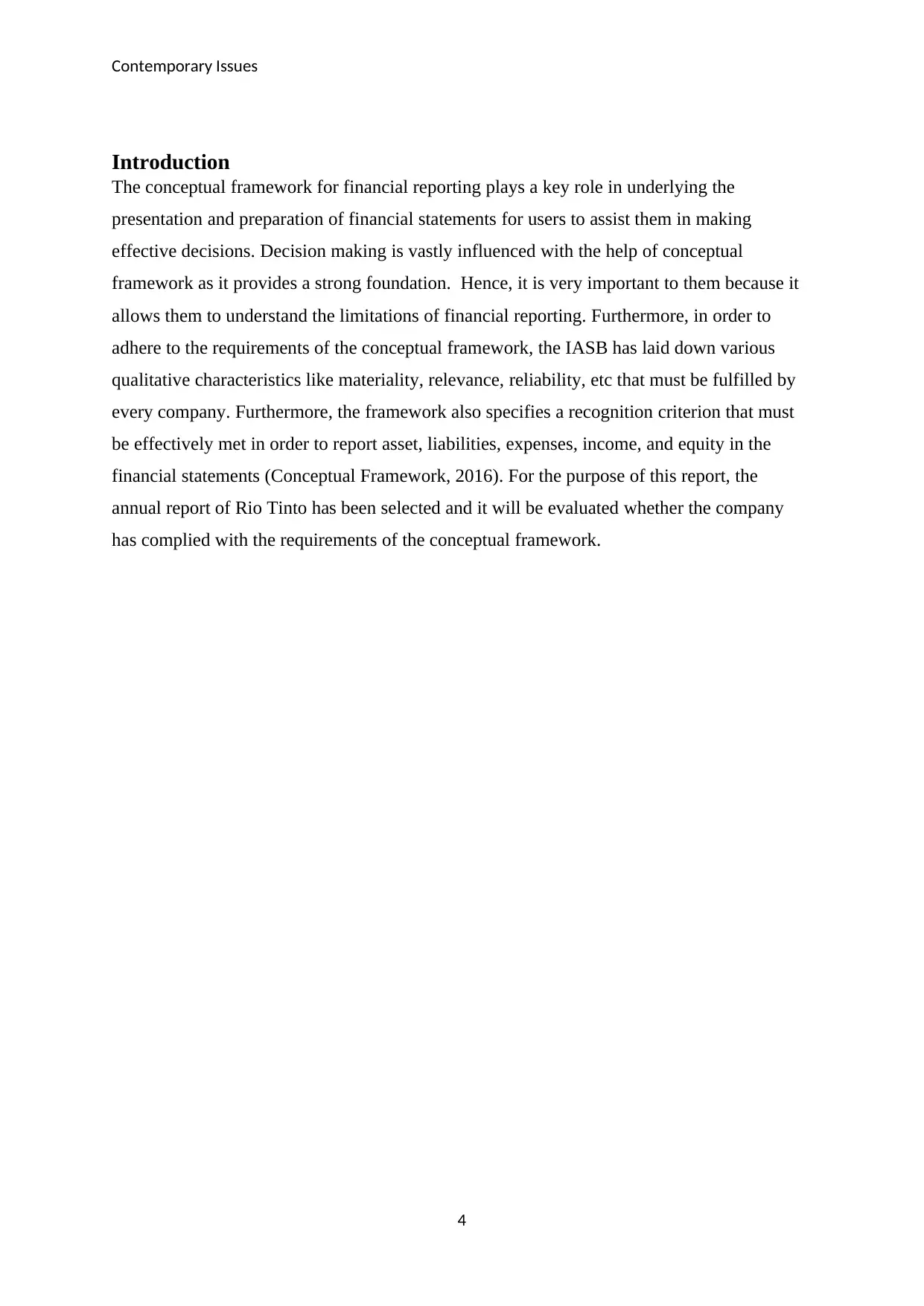
Contemporary Issues
Introduction
The conceptual framework for financial reporting plays a key role in underlying the
presentation and preparation of financial statements for users to assist them in making
effective decisions. Decision making is vastly influenced with the help of conceptual
framework as it provides a strong foundation. Hence, it is very important to them because it
allows them to understand the limitations of financial reporting. Furthermore, in order to
adhere to the requirements of the conceptual framework, the IASB has laid down various
qualitative characteristics like materiality, relevance, reliability, etc that must be fulfilled by
every company. Furthermore, the framework also specifies a recognition criterion that must
be effectively met in order to report asset, liabilities, expenses, income, and equity in the
financial statements (Conceptual Framework, 2016). For the purpose of this report, the
annual report of Rio Tinto has been selected and it will be evaluated whether the company
has complied with the requirements of the conceptual framework.
4
Introduction
The conceptual framework for financial reporting plays a key role in underlying the
presentation and preparation of financial statements for users to assist them in making
effective decisions. Decision making is vastly influenced with the help of conceptual
framework as it provides a strong foundation. Hence, it is very important to them because it
allows them to understand the limitations of financial reporting. Furthermore, in order to
adhere to the requirements of the conceptual framework, the IASB has laid down various
qualitative characteristics like materiality, relevance, reliability, etc that must be fulfilled by
every company. Furthermore, the framework also specifies a recognition criterion that must
be effectively met in order to report asset, liabilities, expenses, income, and equity in the
financial statements (Conceptual Framework, 2016). For the purpose of this report, the
annual report of Rio Tinto has been selected and it will be evaluated whether the company
has complied with the requirements of the conceptual framework.
4
Paraphrase This Document
Need a fresh take? Get an instant paraphrase of this document with our AI Paraphraser
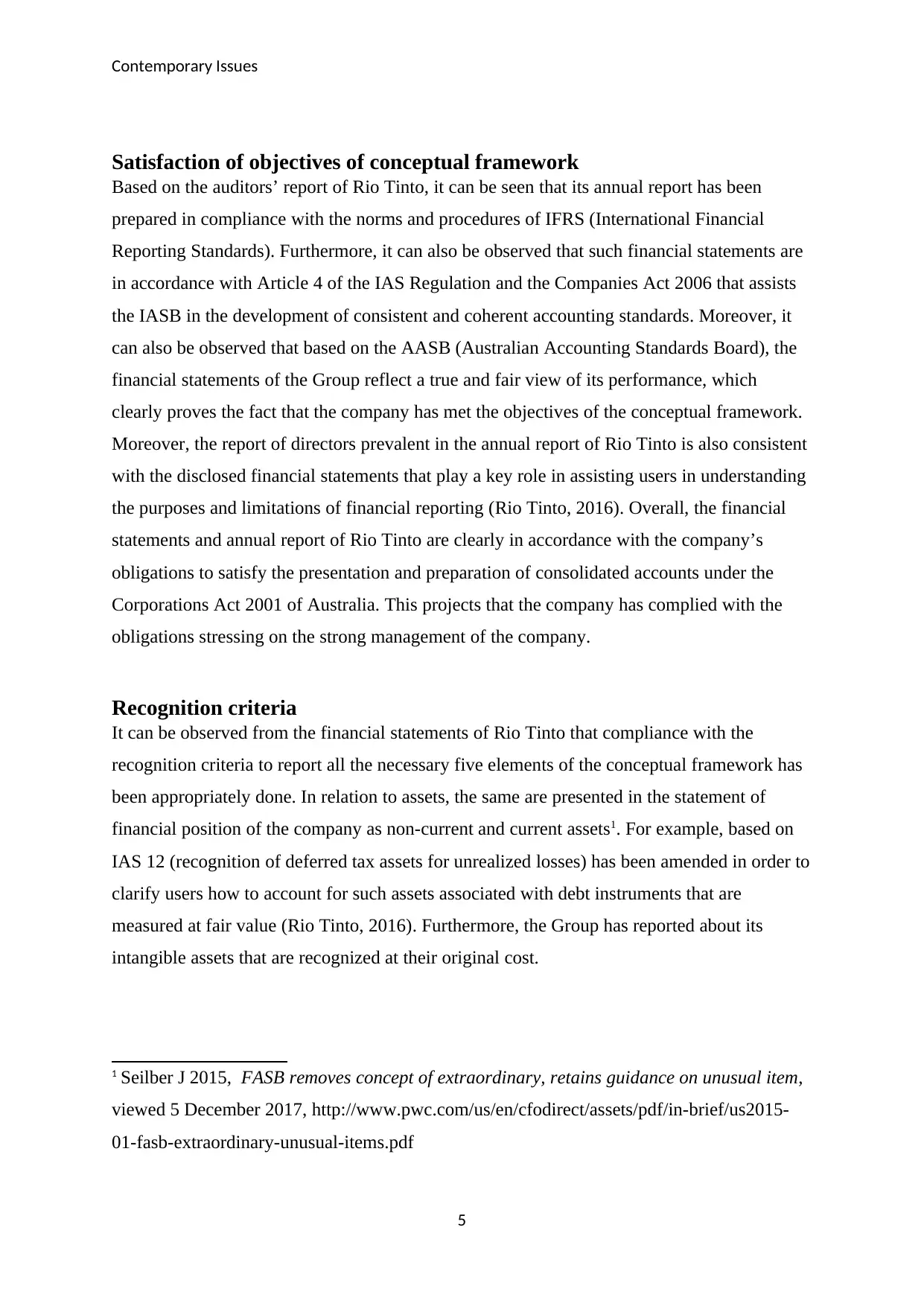
Contemporary Issues
Satisfaction of objectives of conceptual framework
Based on the auditors’ report of Rio Tinto, it can be seen that its annual report has been
prepared in compliance with the norms and procedures of IFRS (International Financial
Reporting Standards). Furthermore, it can also be observed that such financial statements are
in accordance with Article 4 of the IAS Regulation and the Companies Act 2006 that assists
the IASB in the development of consistent and coherent accounting standards. Moreover, it
can also be observed that based on the AASB (Australian Accounting Standards Board), the
financial statements of the Group reflect a true and fair view of its performance, which
clearly proves the fact that the company has met the objectives of the conceptual framework.
Moreover, the report of directors prevalent in the annual report of Rio Tinto is also consistent
with the disclosed financial statements that play a key role in assisting users in understanding
the purposes and limitations of financial reporting (Rio Tinto, 2016). Overall, the financial
statements and annual report of Rio Tinto are clearly in accordance with the company’s
obligations to satisfy the presentation and preparation of consolidated accounts under the
Corporations Act 2001 of Australia. This projects that the company has complied with the
obligations stressing on the strong management of the company.
Recognition criteria
It can be observed from the financial statements of Rio Tinto that compliance with the
recognition criteria to report all the necessary five elements of the conceptual framework has
been appropriately done. In relation to assets, the same are presented in the statement of
financial position of the company as non-current and current assets1. For example, based on
IAS 12 (recognition of deferred tax assets for unrealized losses) has been amended in order to
clarify users how to account for such assets associated with debt instruments that are
measured at fair value (Rio Tinto, 2016). Furthermore, the Group has reported about its
intangible assets that are recognized at their original cost.
1 Seilber J 2015, FASB removes concept of extraordinary, retains guidance on unusual item,
viewed 5 December 2017, http://www.pwc.com/us/en/cfodirect/assets/pdf/in-brief/us2015-
01-fasb-extraordinary-unusual-items.pdf
5
Satisfaction of objectives of conceptual framework
Based on the auditors’ report of Rio Tinto, it can be seen that its annual report has been
prepared in compliance with the norms and procedures of IFRS (International Financial
Reporting Standards). Furthermore, it can also be observed that such financial statements are
in accordance with Article 4 of the IAS Regulation and the Companies Act 2006 that assists
the IASB in the development of consistent and coherent accounting standards. Moreover, it
can also be observed that based on the AASB (Australian Accounting Standards Board), the
financial statements of the Group reflect a true and fair view of its performance, which
clearly proves the fact that the company has met the objectives of the conceptual framework.
Moreover, the report of directors prevalent in the annual report of Rio Tinto is also consistent
with the disclosed financial statements that play a key role in assisting users in understanding
the purposes and limitations of financial reporting (Rio Tinto, 2016). Overall, the financial
statements and annual report of Rio Tinto are clearly in accordance with the company’s
obligations to satisfy the presentation and preparation of consolidated accounts under the
Corporations Act 2001 of Australia. This projects that the company has complied with the
obligations stressing on the strong management of the company.
Recognition criteria
It can be observed from the financial statements of Rio Tinto that compliance with the
recognition criteria to report all the necessary five elements of the conceptual framework has
been appropriately done. In relation to assets, the same are presented in the statement of
financial position of the company as non-current and current assets1. For example, based on
IAS 12 (recognition of deferred tax assets for unrealized losses) has been amended in order to
clarify users how to account for such assets associated with debt instruments that are
measured at fair value (Rio Tinto, 2016). Furthermore, the Group has reported about its
intangible assets that are recognized at their original cost.
1 Seilber J 2015, FASB removes concept of extraordinary, retains guidance on unusual item,
viewed 5 December 2017, http://www.pwc.com/us/en/cfodirect/assets/pdf/in-brief/us2015-
01-fasb-extraordinary-unusual-items.pdf
5
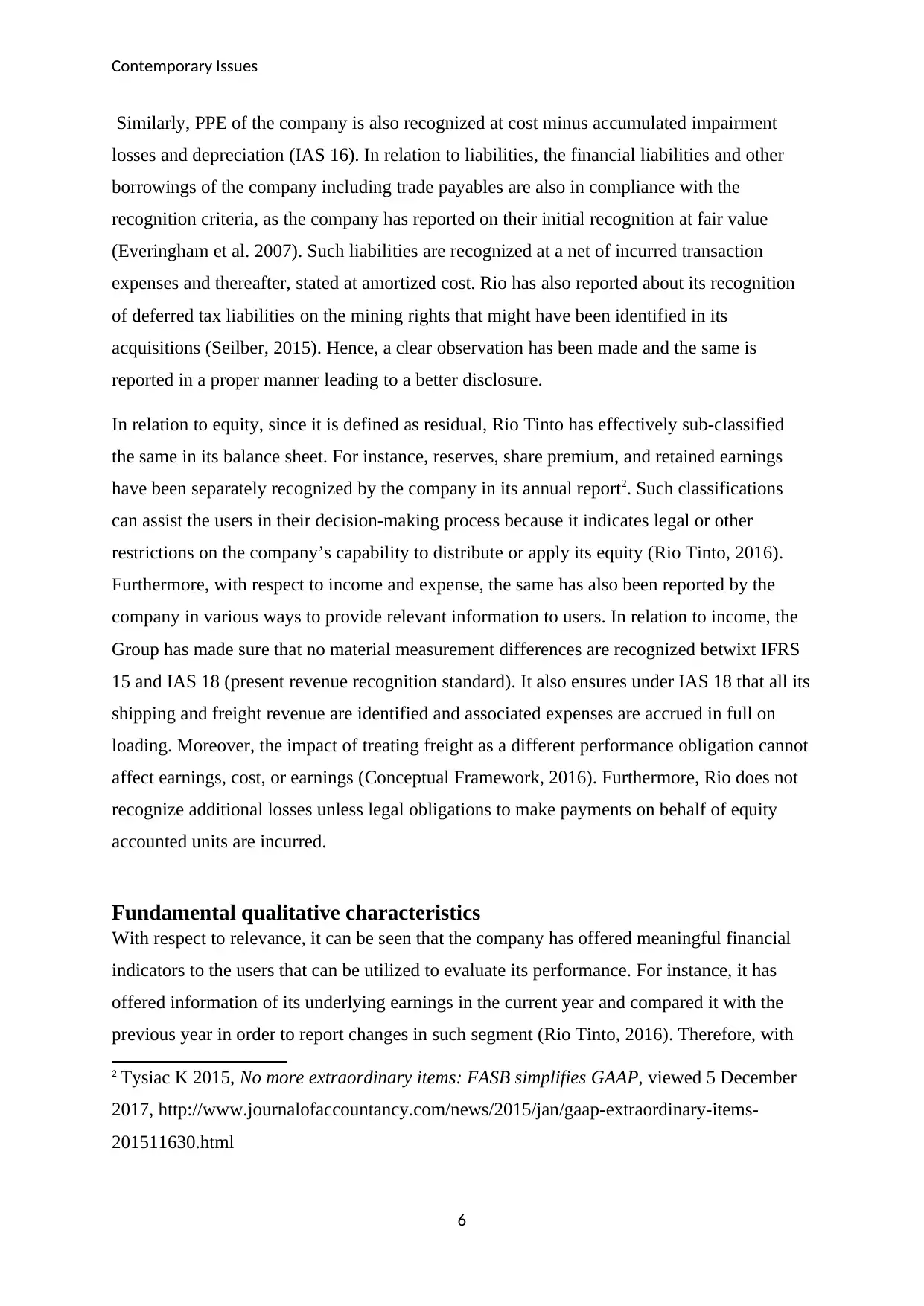
Contemporary Issues
Similarly, PPE of the company is also recognized at cost minus accumulated impairment
losses and depreciation (IAS 16). In relation to liabilities, the financial liabilities and other
borrowings of the company including trade payables are also in compliance with the
recognition criteria, as the company has reported on their initial recognition at fair value
(Everingham et al. 2007). Such liabilities are recognized at a net of incurred transaction
expenses and thereafter, stated at amortized cost. Rio has also reported about its recognition
of deferred tax liabilities on the mining rights that might have been identified in its
acquisitions (Seilber, 2015). Hence, a clear observation has been made and the same is
reported in a proper manner leading to a better disclosure.
In relation to equity, since it is defined as residual, Rio Tinto has effectively sub-classified
the same in its balance sheet. For instance, reserves, share premium, and retained earnings
have been separately recognized by the company in its annual report2. Such classifications
can assist the users in their decision-making process because it indicates legal or other
restrictions on the company’s capability to distribute or apply its equity (Rio Tinto, 2016).
Furthermore, with respect to income and expense, the same has also been reported by the
company in various ways to provide relevant information to users. In relation to income, the
Group has made sure that no material measurement differences are recognized betwixt IFRS
15 and IAS 18 (present revenue recognition standard). It also ensures under IAS 18 that all its
shipping and freight revenue are identified and associated expenses are accrued in full on
loading. Moreover, the impact of treating freight as a different performance obligation cannot
affect earnings, cost, or earnings (Conceptual Framework, 2016). Furthermore, Rio does not
recognize additional losses unless legal obligations to make payments on behalf of equity
accounted units are incurred.
Fundamental qualitative characteristics
With respect to relevance, it can be seen that the company has offered meaningful financial
indicators to the users that can be utilized to evaluate its performance. For instance, it has
offered information of its underlying earnings in the current year and compared it with the
previous year in order to report changes in such segment (Rio Tinto, 2016). Therefore, with
2 Tysiac K 2015, No more extraordinary items: FASB simplifies GAAP, viewed 5 December
2017, http://www.journalofaccountancy.com/news/2015/jan/gaap-extraordinary-items-
201511630.html
6
Similarly, PPE of the company is also recognized at cost minus accumulated impairment
losses and depreciation (IAS 16). In relation to liabilities, the financial liabilities and other
borrowings of the company including trade payables are also in compliance with the
recognition criteria, as the company has reported on their initial recognition at fair value
(Everingham et al. 2007). Such liabilities are recognized at a net of incurred transaction
expenses and thereafter, stated at amortized cost. Rio has also reported about its recognition
of deferred tax liabilities on the mining rights that might have been identified in its
acquisitions (Seilber, 2015). Hence, a clear observation has been made and the same is
reported in a proper manner leading to a better disclosure.
In relation to equity, since it is defined as residual, Rio Tinto has effectively sub-classified
the same in its balance sheet. For instance, reserves, share premium, and retained earnings
have been separately recognized by the company in its annual report2. Such classifications
can assist the users in their decision-making process because it indicates legal or other
restrictions on the company’s capability to distribute or apply its equity (Rio Tinto, 2016).
Furthermore, with respect to income and expense, the same has also been reported by the
company in various ways to provide relevant information to users. In relation to income, the
Group has made sure that no material measurement differences are recognized betwixt IFRS
15 and IAS 18 (present revenue recognition standard). It also ensures under IAS 18 that all its
shipping and freight revenue are identified and associated expenses are accrued in full on
loading. Moreover, the impact of treating freight as a different performance obligation cannot
affect earnings, cost, or earnings (Conceptual Framework, 2016). Furthermore, Rio does not
recognize additional losses unless legal obligations to make payments on behalf of equity
accounted units are incurred.
Fundamental qualitative characteristics
With respect to relevance, it can be seen that the company has offered meaningful financial
indicators to the users that can be utilized to evaluate its performance. For instance, it has
offered information of its underlying earnings in the current year and compared it with the
previous year in order to report changes in such segment (Rio Tinto, 2016). Therefore, with
2 Tysiac K 2015, No more extraordinary items: FASB simplifies GAAP, viewed 5 December
2017, http://www.journalofaccountancy.com/news/2015/jan/gaap-extraordinary-items-
201511630.html
6
⊘ This is a preview!⊘
Do you want full access?
Subscribe today to unlock all pages.

Trusted by 1+ million students worldwide
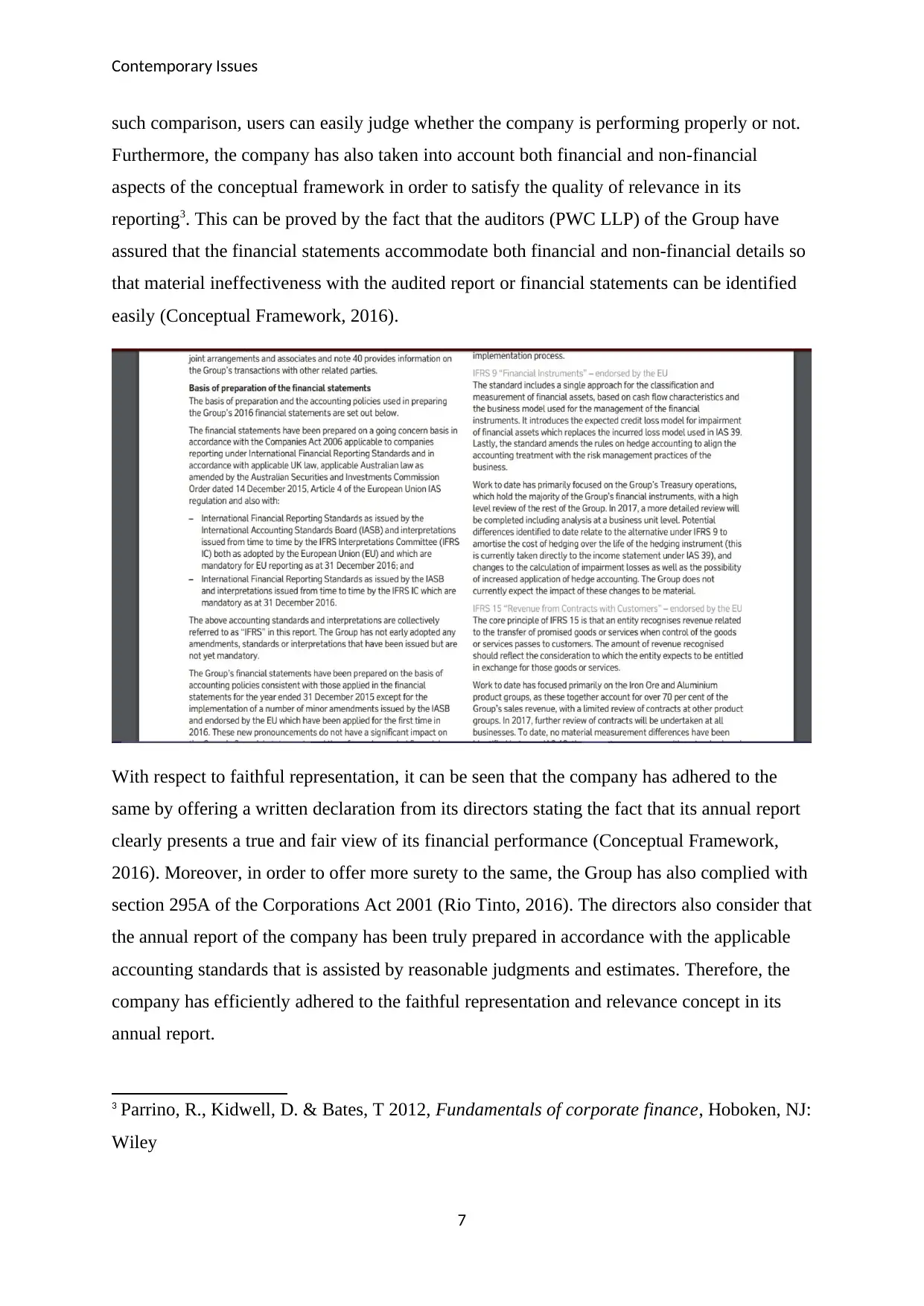
Contemporary Issues
such comparison, users can easily judge whether the company is performing properly or not.
Furthermore, the company has also taken into account both financial and non-financial
aspects of the conceptual framework in order to satisfy the quality of relevance in its
reporting3. This can be proved by the fact that the auditors (PWC LLP) of the Group have
assured that the financial statements accommodate both financial and non-financial details so
that material ineffectiveness with the audited report or financial statements can be identified
easily (Conceptual Framework, 2016).
With respect to faithful representation, it can be seen that the company has adhered to the
same by offering a written declaration from its directors stating the fact that its annual report
clearly presents a true and fair view of its financial performance (Conceptual Framework,
2016). Moreover, in order to offer more surety to the same, the Group has also complied with
section 295A of the Corporations Act 2001 (Rio Tinto, 2016). The directors also consider that
the annual report of the company has been truly prepared in accordance with the applicable
accounting standards that is assisted by reasonable judgments and estimates. Therefore, the
company has efficiently adhered to the faithful representation and relevance concept in its
annual report.
3 Parrino, R., Kidwell, D. & Bates, T 2012, Fundamentals of corporate finance, Hoboken, NJ:
Wiley
7
such comparison, users can easily judge whether the company is performing properly or not.
Furthermore, the company has also taken into account both financial and non-financial
aspects of the conceptual framework in order to satisfy the quality of relevance in its
reporting3. This can be proved by the fact that the auditors (PWC LLP) of the Group have
assured that the financial statements accommodate both financial and non-financial details so
that material ineffectiveness with the audited report or financial statements can be identified
easily (Conceptual Framework, 2016).
With respect to faithful representation, it can be seen that the company has adhered to the
same by offering a written declaration from its directors stating the fact that its annual report
clearly presents a true and fair view of its financial performance (Conceptual Framework,
2016). Moreover, in order to offer more surety to the same, the Group has also complied with
section 295A of the Corporations Act 2001 (Rio Tinto, 2016). The directors also consider that
the annual report of the company has been truly prepared in accordance with the applicable
accounting standards that is assisted by reasonable judgments and estimates. Therefore, the
company has efficiently adhered to the faithful representation and relevance concept in its
annual report.
3 Parrino, R., Kidwell, D. & Bates, T 2012, Fundamentals of corporate finance, Hoboken, NJ:
Wiley
7
Paraphrase This Document
Need a fresh take? Get an instant paraphrase of this document with our AI Paraphraser
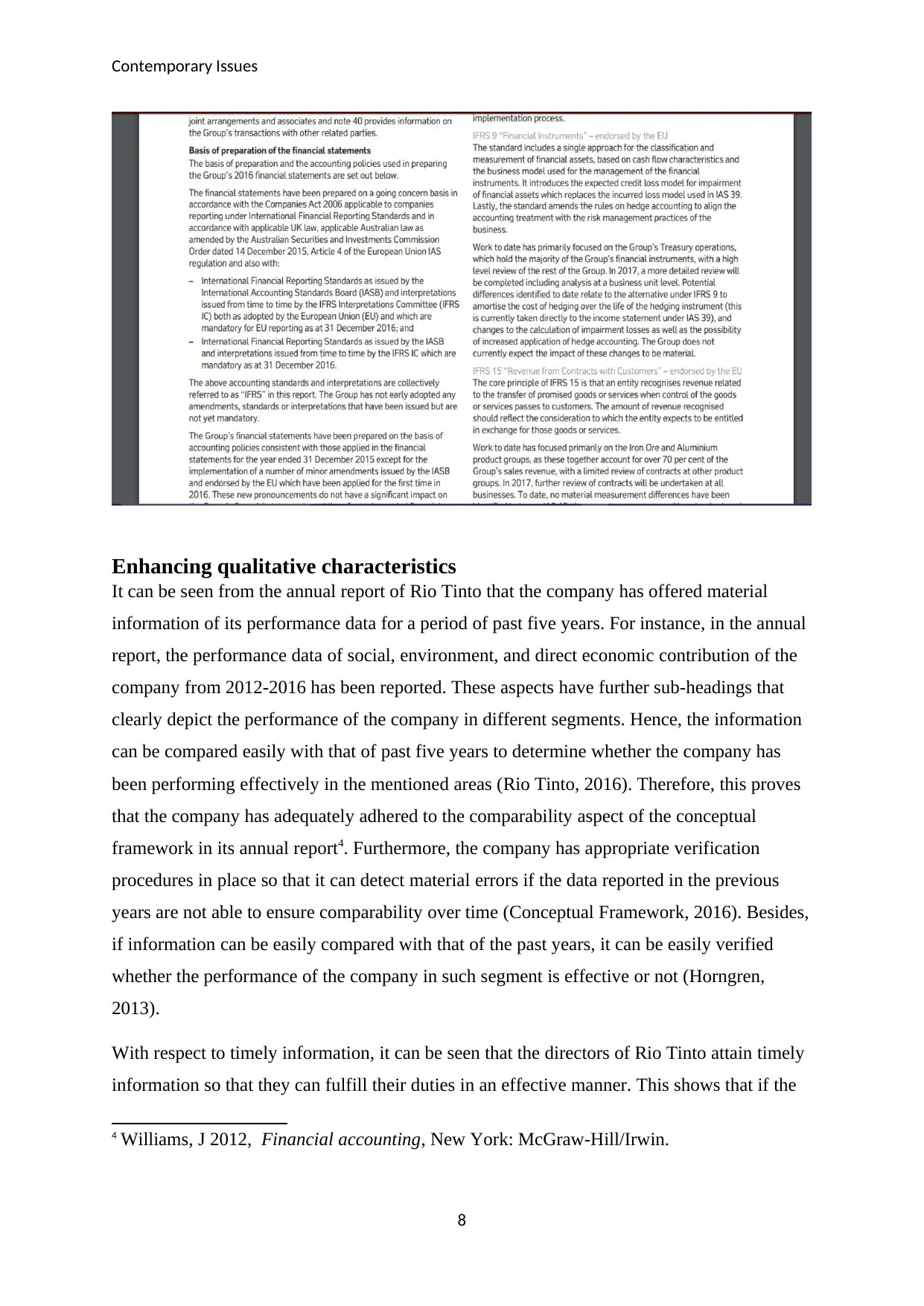
Contemporary Issues
Enhancing qualitative characteristics
It can be seen from the annual report of Rio Tinto that the company has offered material
information of its performance data for a period of past five years. For instance, in the annual
report, the performance data of social, environment, and direct economic contribution of the
company from 2012-2016 has been reported. These aspects have further sub-headings that
clearly depict the performance of the company in different segments. Hence, the information
can be compared easily with that of past five years to determine whether the company has
been performing effectively in the mentioned areas (Rio Tinto, 2016). Therefore, this proves
that the company has adequately adhered to the comparability aspect of the conceptual
framework in its annual report4. Furthermore, the company has appropriate verification
procedures in place so that it can detect material errors if the data reported in the previous
years are not able to ensure comparability over time (Conceptual Framework, 2016). Besides,
if information can be easily compared with that of the past years, it can be easily verified
whether the performance of the company in such segment is effective or not (Horngren,
2013).
With respect to timely information, it can be seen that the directors of Rio Tinto attain timely
information so that they can fulfill their duties in an effective manner. This shows that if the
4 Williams, J 2012, Financial accounting, New York: McGraw-Hill/Irwin.
8
Enhancing qualitative characteristics
It can be seen from the annual report of Rio Tinto that the company has offered material
information of its performance data for a period of past five years. For instance, in the annual
report, the performance data of social, environment, and direct economic contribution of the
company from 2012-2016 has been reported. These aspects have further sub-headings that
clearly depict the performance of the company in different segments. Hence, the information
can be compared easily with that of past five years to determine whether the company has
been performing effectively in the mentioned areas (Rio Tinto, 2016). Therefore, this proves
that the company has adequately adhered to the comparability aspect of the conceptual
framework in its annual report4. Furthermore, the company has appropriate verification
procedures in place so that it can detect material errors if the data reported in the previous
years are not able to ensure comparability over time (Conceptual Framework, 2016). Besides,
if information can be easily compared with that of the past years, it can be easily verified
whether the performance of the company in such segment is effective or not (Horngren,
2013).
With respect to timely information, it can be seen that the directors of Rio Tinto attain timely
information so that they can fulfill their duties in an effective manner. This shows that if the
4 Williams, J 2012, Financial accounting, New York: McGraw-Hill/Irwin.
8
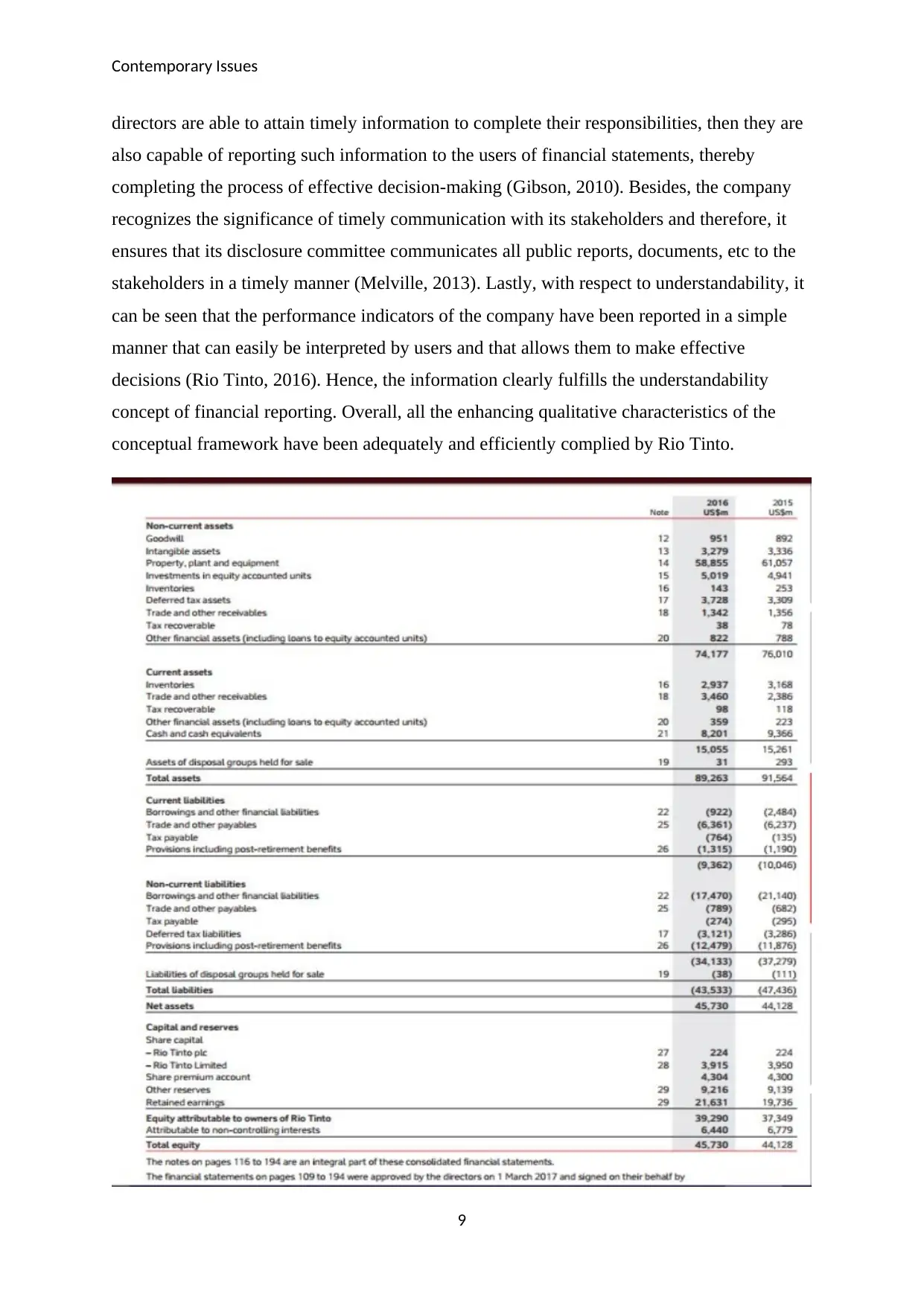
Contemporary Issues
directors are able to attain timely information to complete their responsibilities, then they are
also capable of reporting such information to the users of financial statements, thereby
completing the process of effective decision-making (Gibson, 2010). Besides, the company
recognizes the significance of timely communication with its stakeholders and therefore, it
ensures that its disclosure committee communicates all public reports, documents, etc to the
stakeholders in a timely manner (Melville, 2013). Lastly, with respect to understandability, it
can be seen that the performance indicators of the company have been reported in a simple
manner that can easily be interpreted by users and that allows them to make effective
decisions (Rio Tinto, 2016). Hence, the information clearly fulfills the understandability
concept of financial reporting. Overall, all the enhancing qualitative characteristics of the
conceptual framework have been adequately and efficiently complied by Rio Tinto.
9
directors are able to attain timely information to complete their responsibilities, then they are
also capable of reporting such information to the users of financial statements, thereby
completing the process of effective decision-making (Gibson, 2010). Besides, the company
recognizes the significance of timely communication with its stakeholders and therefore, it
ensures that its disclosure committee communicates all public reports, documents, etc to the
stakeholders in a timely manner (Melville, 2013). Lastly, with respect to understandability, it
can be seen that the performance indicators of the company have been reported in a simple
manner that can easily be interpreted by users and that allows them to make effective
decisions (Rio Tinto, 2016). Hence, the information clearly fulfills the understandability
concept of financial reporting. Overall, all the enhancing qualitative characteristics of the
conceptual framework have been adequately and efficiently complied by Rio Tinto.
9
⊘ This is a preview!⊘
Do you want full access?
Subscribe today to unlock all pages.

Trusted by 1+ million students worldwide
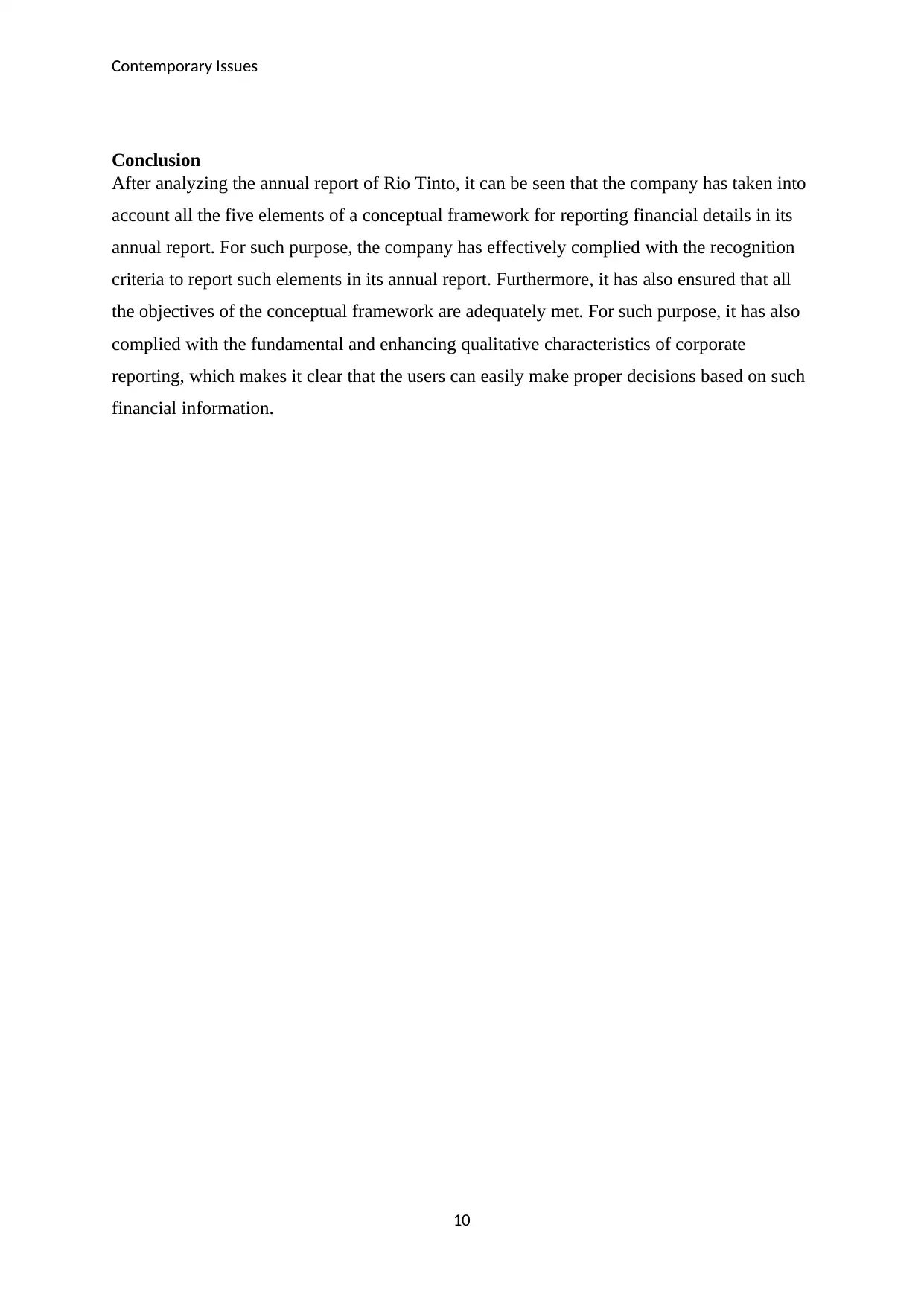
Contemporary Issues
Conclusion
After analyzing the annual report of Rio Tinto, it can be seen that the company has taken into
account all the five elements of a conceptual framework for reporting financial details in its
annual report. For such purpose, the company has effectively complied with the recognition
criteria to report such elements in its annual report. Furthermore, it has also ensured that all
the objectives of the conceptual framework are adequately met. For such purpose, it has also
complied with the fundamental and enhancing qualitative characteristics of corporate
reporting, which makes it clear that the users can easily make proper decisions based on such
financial information.
10
Conclusion
After analyzing the annual report of Rio Tinto, it can be seen that the company has taken into
account all the five elements of a conceptual framework for reporting financial details in its
annual report. For such purpose, the company has effectively complied with the recognition
criteria to report such elements in its annual report. Furthermore, it has also ensured that all
the objectives of the conceptual framework are adequately met. For such purpose, it has also
complied with the fundamental and enhancing qualitative characteristics of corporate
reporting, which makes it clear that the users can easily make proper decisions based on such
financial information.
10
Paraphrase This Document
Need a fresh take? Get an instant paraphrase of this document with our AI Paraphraser
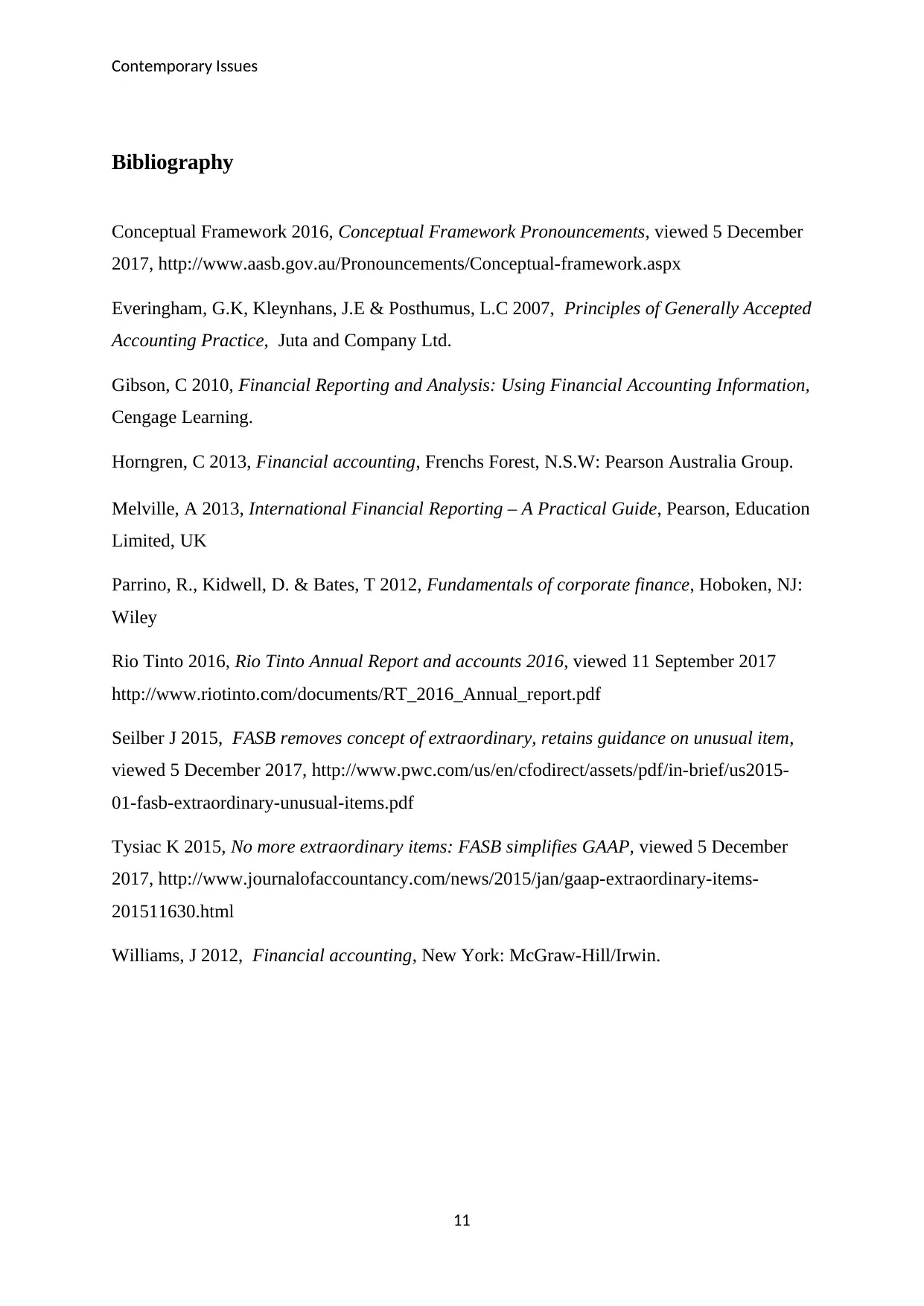
Contemporary Issues
Bibliography
Conceptual Framework 2016, Conceptual Framework Pronouncements, viewed 5 December
2017, http://www.aasb.gov.au/Pronouncements/Conceptual-framework.aspx
Everingham, G.K, Kleynhans, J.E & Posthumus, L.C 2007, Principles of Generally Accepted
Accounting Practice, Juta and Company Ltd.
Gibson, C 2010, Financial Reporting and Analysis: Using Financial Accounting Information,
Cengage Learning.
Horngren, C 2013, Financial accounting, Frenchs Forest, N.S.W: Pearson Australia Group.
Melville, A 2013, International Financial Reporting – A Practical Guide, Pearson, Education
Limited, UK
Parrino, R., Kidwell, D. & Bates, T 2012, Fundamentals of corporate finance, Hoboken, NJ:
Wiley
Rio Tinto 2016, Rio Tinto Annual Report and accounts 2016, viewed 11 September 2017
http://www.riotinto.com/documents/RT_2016_Annual_report.pdf
Seilber J 2015, FASB removes concept of extraordinary, retains guidance on unusual item,
viewed 5 December 2017, http://www.pwc.com/us/en/cfodirect/assets/pdf/in-brief/us2015-
01-fasb-extraordinary-unusual-items.pdf
Tysiac K 2015, No more extraordinary items: FASB simplifies GAAP, viewed 5 December
2017, http://www.journalofaccountancy.com/news/2015/jan/gaap-extraordinary-items-
201511630.html
Williams, J 2012, Financial accounting, New York: McGraw-Hill/Irwin.
11
Bibliography
Conceptual Framework 2016, Conceptual Framework Pronouncements, viewed 5 December
2017, http://www.aasb.gov.au/Pronouncements/Conceptual-framework.aspx
Everingham, G.K, Kleynhans, J.E & Posthumus, L.C 2007, Principles of Generally Accepted
Accounting Practice, Juta and Company Ltd.
Gibson, C 2010, Financial Reporting and Analysis: Using Financial Accounting Information,
Cengage Learning.
Horngren, C 2013, Financial accounting, Frenchs Forest, N.S.W: Pearson Australia Group.
Melville, A 2013, International Financial Reporting – A Practical Guide, Pearson, Education
Limited, UK
Parrino, R., Kidwell, D. & Bates, T 2012, Fundamentals of corporate finance, Hoboken, NJ:
Wiley
Rio Tinto 2016, Rio Tinto Annual Report and accounts 2016, viewed 11 September 2017
http://www.riotinto.com/documents/RT_2016_Annual_report.pdf
Seilber J 2015, FASB removes concept of extraordinary, retains guidance on unusual item,
viewed 5 December 2017, http://www.pwc.com/us/en/cfodirect/assets/pdf/in-brief/us2015-
01-fasb-extraordinary-unusual-items.pdf
Tysiac K 2015, No more extraordinary items: FASB simplifies GAAP, viewed 5 December
2017, http://www.journalofaccountancy.com/news/2015/jan/gaap-extraordinary-items-
201511630.html
Williams, J 2012, Financial accounting, New York: McGraw-Hill/Irwin.
11
1 out of 11
Related Documents
Your All-in-One AI-Powered Toolkit for Academic Success.
+13062052269
info@desklib.com
Available 24*7 on WhatsApp / Email
![[object Object]](/_next/static/media/star-bottom.7253800d.svg)
Unlock your academic potential
Copyright © 2020–2025 A2Z Services. All Rights Reserved. Developed and managed by ZUCOL.




